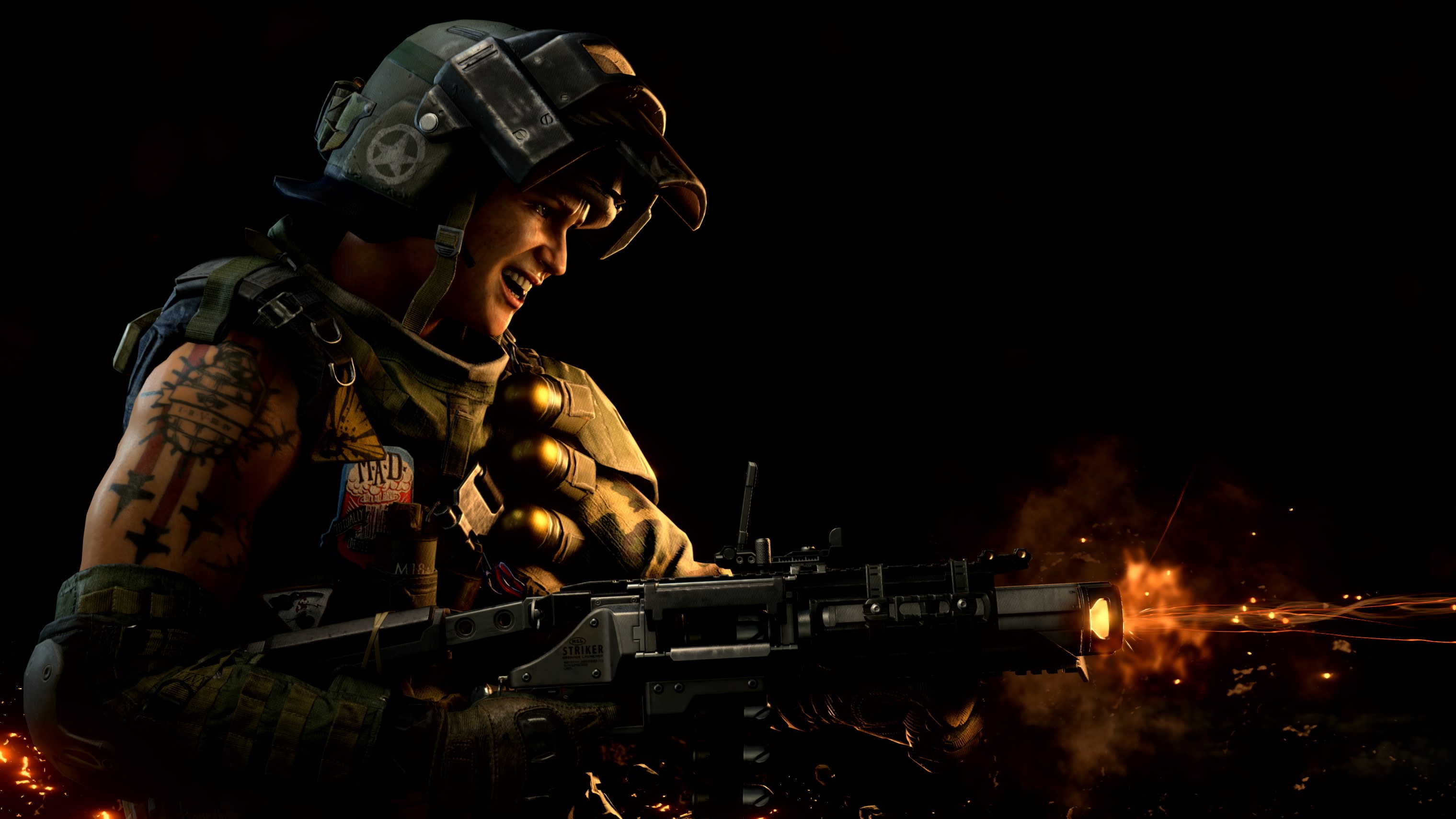Black Ops 4 borrows from Overwatch and Siege to finally modernize Call of Duty
Specialist abilities, manual healing, and UI changes make teamwork and map awareness as valuable as good aim in Black Ops 4.

Black Ops 4 is the series' first truly modern shooter in years. The days of 720 no-scoping your way through a match just might be gone. Early indicators showed up in Black Ops 3, but Call of Duty: Black Ops 4 has fully transformed into a 5v5 team-based class shooter now. It's still an agile FPS with short time-to-kill, of course, but now you've gotta worry about healing yourself, sharing intel, and Firebreak's reactor core.
I run into Firebreak in the shelled husk of a church. I don't actually see him, but he's set the floor on fire, the madman, and permanently damaged a part of my health bar. Shooting him would do the trick, but so would support from a teammate healing me with their special ability through the wall, or a temporary wallhack from another friend that would let me know where the bastard is hiding. I'm surprised I didn't run into an affable gorilla scientist class during my two hours of hands-on with Black Ops 4's primary multiplayer mode (though Specialist Ruin's Grav Slam ability certainly echoes angry Winston).
Of course, Black Ops 4 is not Overwatch, not by a long shot, but the influence from its sibling within the parent company is clear. With special abilities and class synergies and visible health bars, Black Ops 4 values trading information as much as shooting men in the face.
New intel
Let's start with the basics so as not to disorient BLOPS loyalists. Like Call of Duty: WW2, Black Ops 4's locomotion removes the wall runs and dashes introduced in the last few iterations, keeping those boots firmly planted on the ground, while making minor tweaks to the health system and UI that have massive implications. Automatically regenerating health (introduced waaay back in Call of Duty 2) is gone, replaced with an infinite supply of stimpacks you jam into your arm. When you're stimming, you can't shoot, and this new method of manual healing slows down the pace of a match. Combat is still as fast as ever, but deciding whether to look for a fight or run from one depends on 1) your health, 2) your enemy's health, and 3) whether either of you have a stimpack ready to go. It's a major change from just finding cover for a few seconds then diving back in.
Health is also more transparent. HP bars are visible for both teammates and players within range, and I found myself making moves based on the the combined health of nearby teammates. If we lit up a group of enemies and took a considerable amount of health off them, we could safely bet they'd be vulnerable for a few seconds while they healed. Likewise, if my health had taken a dangerous hit and I'd already popped my stim, I'd effectively be forced out of combat for around 10 seconds, leaving an objective wide open for the other team. Depending on the game mode, I'm not sure what's worse: hiding to lick your wounds or a swift death and instant respawn. I do like that it results in a much more palpable sense of whether the odds are in or against your favor throughout the match, encouraging and rewarding more deliberate communication and play-making. Will the same teamwork occur naturally in the wild? Treyarch is banking on it.
Changes to the radar feed into the same team-focused design. The mini-map is enveloped in a 'fog of war', and the only illuminated areas are around yourself and teammates. Within each pocket of visibility on the mini-map all enemy players will be revealed, with the exception of any that have a negating perk equipped. Rather than lighting up everything for everyone when a UAV is deployed, or when an enemy player shoots, valuable intel is exclusive to your immediate surroundings, but it's always available (barring a radar scrambling killstreak or invisibility perk). My favorite touch is the emphasis on total damage dealt and objective points rather than K/D ratio in the score screen. Team contributions are given the highest respect in Black Ops 4.
Classy
They're not my favorite FPS weapons, but they've come to feel as reliable as an old pickup truck.
Specialist character classes, some old some new, make a return from Black Ops 3, heavily reworked to focus on map awareness and team play. And like Overwatch or Rainbow Six Siege, teams can only have one of each in play during a match. I've yet to try them all, but they're customizable enough that switching between them isn't disorienting. Each comes with their own special gadget and ability, but you can change their loadouts to fit any role. Perks and moddable weapons fill out the bulk of the loadout system, and while I didn't have enough time to experiment with every tool in the arsenal, what I did use felt familiar.
Keep up to date with the most important stories and the best deals, as picked by the PC Gamer team.
All the Call of Duty weapon archetypes are back in snipers, bolt-action rifles, SMGs, assault rifles, LMGs, shotguns, and pistols. The snappy, crowded sight aim and trademark phbt-phbt of the hit indicator homogenizes weapon feedback and still drives me crazy. They're not my favorite FPS weapons, but they've come to feel as reliable as an old pickup truck.
Besides, it's the new class abilities and a few of the new gadgets that augment exactly how you get into firefights in the first place. I favored a character named Torque, whose default loadout includes deployable razor wire meant for blocking chokepoints to slow down and damage enemies. I found it particularly useful for placing on flanking routes because anytime an enemy walks over it, you get it a notification that you're doing damage, a lot like Lesion in Rainbow Six Siege. It's effectively an alarm system for keeping track of your backside, and a good reminder to let your teammates know where the enemy team might be coming from.
Over a longer time, Torque can deploy a big shield for cover, another Siege-y hallmark. During matches where we had to defend a point, it was great for popping into a corner that would otherwise be open and visible to enemies from multiple entryways. (The Siege similarities don't stop there. I mean, there's even a Specialist with the ability to deploy a portable, full body riot shield.)
Firebreak worked for me too because I can't aim worth a damn and he can deploy a small nuclear reactor that does burning damage in a large radius while you hide. The longer you hold it, the more damage it does, and you can even over charge the thing, burning yourself and sacrificing health to hold down an area. It's extremely useful for pushing an established team off an objective. Because the ability works through walls, as long as you have a general idea where the team is camped out (and hopefully your team helped out with that), you can chase those fools right outta town. In tandem with gadget ability that shows enemy locations through walls, and for all your teammates this time, it's monstrously satisfying.
I used it to win a match of Control, which has one team attempt to take two objectives and another defend them, each side with a stock of 25 lives to keep them afloat. We were just a few deaths away from elimination with the enemy team guarding the final point. I held that reactor until I too went up in flames, but took the entire enemy team with me. Not a single headshot required, and rather than find a corpse to teabag, I found a teammate to high five. I forgot I was playing Call of Duty.
But a swift death from an enemy helicopter too often reminded me. Killstreaks are still around, and largely unchanged. UAVs and radar scramblers and missile strikes are back, though they feel more arbitrary than ever set against the design changes meant to reward intelligent play over all else. While I always had a grip on where enemy players were, the occasional missile dropping from the sky or helicopter death or radar scramble almost always blindside. And if no one on your team has something to counter a killstreak reward with, the flow of play is totally staunched. The maps I played didn't deviate from COD's format either: three tight lanes with intertwining flanking routes. A more tactical pace of play elevates them a touch, but I'd love to see something new already. That'll be Blackout, I guess.
So it's not a total reinvention, but still I'm excited (and a bit terrified) to see how longtime players react to the subtly forced companionship, and what strange synergies we'll see once players get more time with the all the character classes and loadout pools. By simply changing what you know, how you heal, and adding some abilities that encourage team play and territory control, Black Ops 4 has finally inched a stagnating series forward.
James is stuck in an endless loop, playing the Dark Souls games on repeat until Elden Ring and Silksong set him free. He's a truffle pig for indie horror and weird FPS games too, seeking out games that actively hurt to play. Otherwise he's wandering Austin, identifying mushrooms and doodling grackles.


